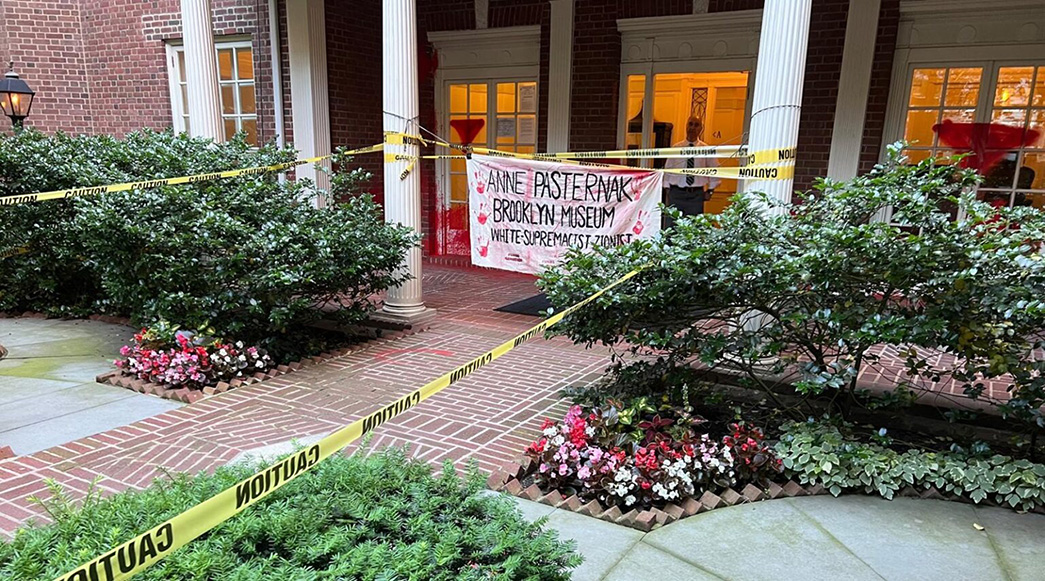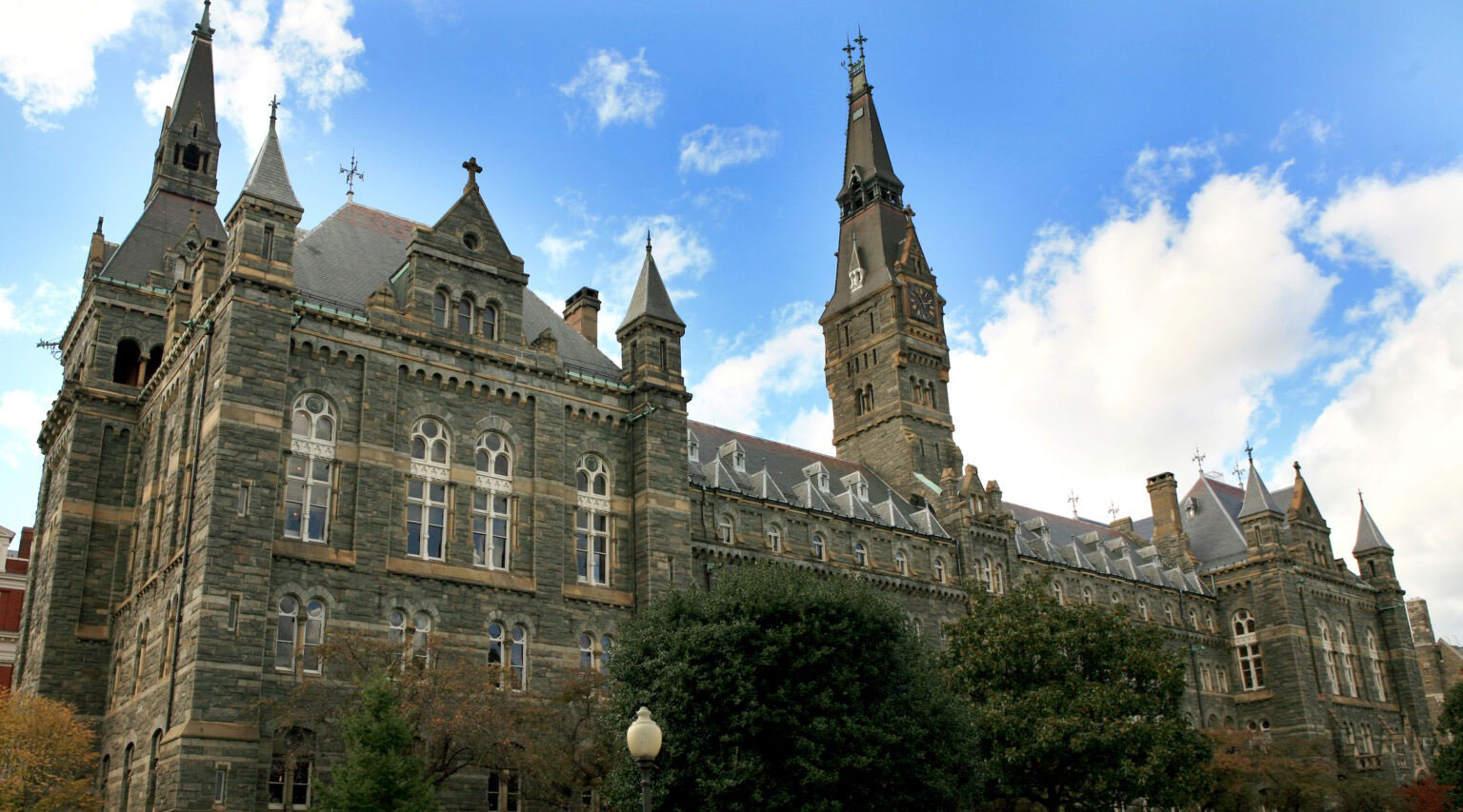Courtesy of JTA. Photo credit: Matt Kane
The vandalization of the residence of Brooklyn Museum director Anne Pasternak on June 12, 2024
(JTA) — Three suspects accused of vandalizing the home of Brooklyn Museum’s Jewish director have now been charged with “making a terroristic threat as a hate crime.”
The charges, announced on Monday, relate to a June incident in which the suspects allegedly tagged the home of Anne Pasternak, the Jewish director of the museum, with inverted red triangles, the symbols Hamas uses in videos to denote Israeli targets that have become popular among pro-Palestinian activists.
The borough’s district attorney, Eric Gonzalez, said Pasternak was targeted due to her Jewish identity and that the red triangle is a symbol belonging to a terror group.
Vandals also targeted the homes of other Brooklyn Museum officials in June, and splattered red paint and wrote the words “blood on your hands” on Pasternak’s home, along with hanging a banner calling her a “white-supremacist Zionist.” The act was part of a campaign against the museum led by the hardline pro-Palestinian activist group Within Our Lifetime.
Gonzalez said in a Monday statement that the defendants allegedly “targeted members of the Brooklyn Museum’s Board of Directors who have Jewish-sounding names and did not target two board members who do not have Jewish-sounding names.” The district attorney’s office did not identify the vandals’ targets by name.
“Acts of vandalism that target individuals in their own homes are a deeply disturbing violation meant to intimidate, terrorize, and instill fear,” Gonzalez said in a statement. “These defendants allegedly targeted museum board members with threats and anti-Semitic graffiti based on their perceived heritage. These actions are not protests; they are hate crimes.”
The statement added, “The red triangles, according to the investigation, are associated with Hamas, a terrorist group.”
The defendants were named as Taylor Pelton, 28, from Astoria, Queens; Samuel Seligson, 32, from Brooklyn; and Gabriel Schubiner, 36, from Bedford-Stuyvesant, Brooklyn. Schubiner, who is Jewish, had also protested a project with Israel’s military while working at Google, was arraigned on Monday and released on bail. Seligson and Pelton are set to be arraigned next week, Gonzalez’s office said. A lawyer for Seligson, whom the AP also identified as Jewish, says he was there as a journalist.
Three other suspects have not yet been apprehended, the district attorney said.
The charges include making a terroristic threat as a hate crime; criminal mischief as a hate crime, and conspiracy as a hate crime. Pelton and Seligson were charged with criminal mischief as a hate crime in July. The terroristic threat charges, and Schubiner’s arrest, were first announced on Monday.
Making a terroristic threat, a class D felony in New York, is defined as the “intent to intimidate or coerce” with threats of murder, assassination or kidnapping. Offenses can be considered hate crimes in New York if the perpetrator selects a target due to their identity.
The added charge marks another stage in the growing prominence of the red triangle in discourse over Israel and Gaza. The charges likely reflect prosecutors’ evolution in how they handle terror symbols, said Mitch Silber, the head of the Community Security Initiative, which coordinates security for Jewish communities in the region.
“I’m not sure a year ago people knew what the red triangles were,” said Silber, the former director of intelligence analysis at the NYPD.
“The more time that this goes on, the more that it’s likely they’re going to get more sophisticated in the way they go about it,” Silber said of prosecutors.
New York legislators have sought to expand the number of crimes that are eligible for hate crimes prosecution in response to the surge in hate crimes, including antisemitic acts, this year. Under New York law, 66 offenses can be considered hate crimes, and a bill introduced last year would expand that list. Under current law, for example, making a terroristic threat can be considered a hate crime, but making graffiti cannot.
In New York State law, hate symbols such as swastikas and nooses are given special treatment in hate crimes prosecution and can elevate an offense to a hate crime. Red triangles may be joining the group of established hate symbols for prosecutors, Silber said.
“Red triangles, it’s new. They don’t have it explicitly in the legislation, so I think prosecutors, district attorneys’ offices are getting creative in how they approach this,” he said. “The legislation hasn’t caught up to the reality, but I think that may be what we’re seeing here.”
He added, “It’s clear the NYPD hate crimes task force has been doing their homework on this and this is going to get everyone’s attention.”
The protests against the museum sparked widespread outrage at the time, drawing condemnation from leaders including Senate Majority Leader Chuck Schumer and Mayor Eric Adams.
The week before the incident, protesters defaced Brooklyn’s iconic OY/YO sculpture in front of the museum with pro-Palestinian graffiti.
The vandalism took place after Within Our Lifetime urged its followers to “take autonomous action” against several New York City museums, sharing a map that marked the Brooklyn Museum, Museum of Modern Art and others with a red inverted triangle.
Protesters had demanded the museum “divest from zionist genocide.”
The leader of Within Our Lifetime, Nerdeen Kiswani, defended the vandalism of Pasternak’s home in a series of posts on social media, saying that police had tackled her during the earlier protest at the museum, which she accused of “supporting genocide.”
Kiswani on Monday attacked the Brooklyn district attorney’s office over the charges, saying the vandals had been “peacefully protesting.”





